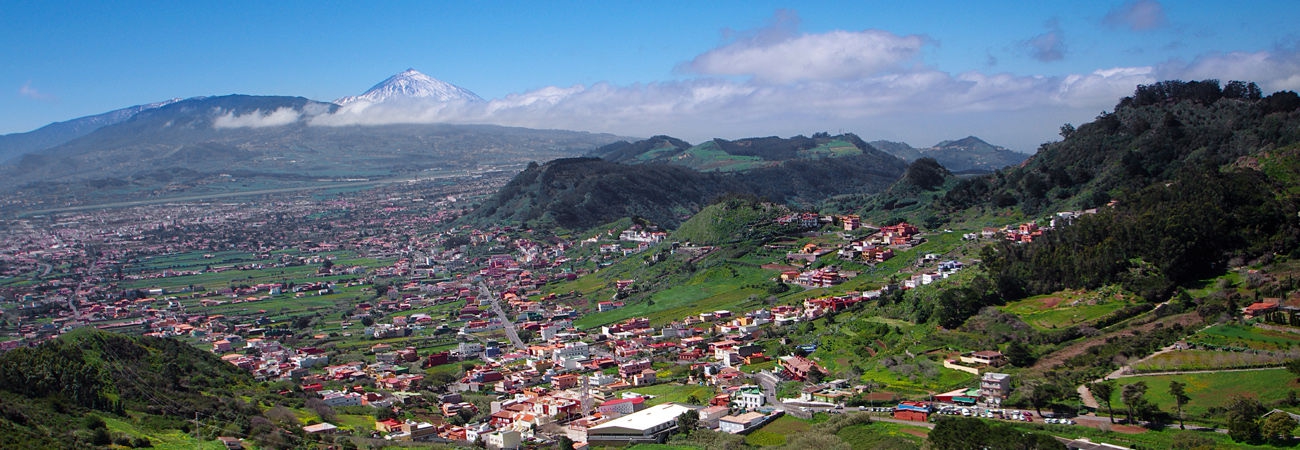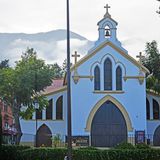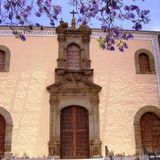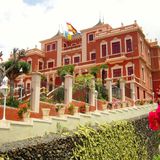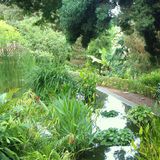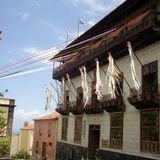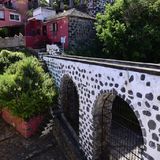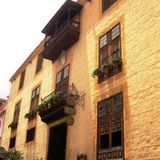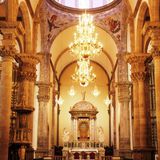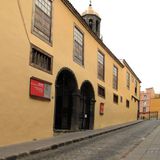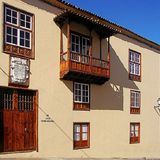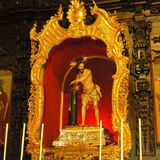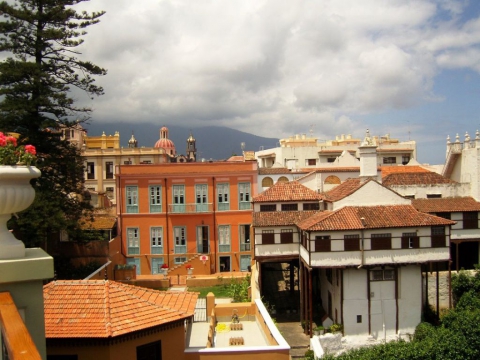La Orotava
HISTORIC MONUMENTAL ROUTE
The town of La Orotava conserves a well defined and specific old town centre that has been declared an historic-artistic site by the Department of Fine Arts on the 8th of May, 1974. This declaration was later ratified by a Decree dated the 10th of December, 1976. The area of historic-artistic interest is listed in the European Cultural Heritage Protection Inventory (ECHPI) as a second order monumental site (file number 03 TF 03). The proposed route to visit the old town centre is as follows:
• Church of El Calvario (near the bus station)
• Calle del Calvario (Plaza de Franchy Alfaro)
• Church of San Agustín and Plaza de la Constitución - Liceo Taoro
• Calle de San Agustín and Carrera del Escultor Estévez
• Town Hall and Annex to the Botanical Gardens - Casa de los Balcones and Casa del Turista (C/ San Francisco)
• Hospital de la Santísima Trinidad - Casa de Ponte-Fonte or Lercaro (C/ Colegio) - Casa Monteverde - Church and Mother House of La Concepción
• Calle Inocencio García and Calle Tomás Zerolo - Casa Torrehermosa (Artenerife) - Church of Santo Domingo and Ex convent of San Benito Abad (Latin American Craft Museum).
CHURCH OF EL CALVARIO
Address: Plaza de La Paz (near the bus station)
In this neo-Gothic church, built in 1914 from drawings by architect Mariano Estanga, the Patron Saints of La Orotava - San Isidro and Santa María de la Cabeza - are worshipped. These are figures made in the 19th century by the great religious sculptor from La Orotava, Fernando Estévez.
Every year, these figures lead the San Isidro Labrador pilgrimage and festival, one of the most important in the Canary Islands, held on the Sunday after the National Corpus Christi celebrations.
The church also contains a remarkable group of sculptures: La Piedad, by the same artist.
CHURCH OF SAN AGUSTIN
CHURCH OF SAN AGUSTIN (EX CONVENT OF NUESTRA SEÑORA DE GRACIA)
Address: Plaza de La Constitución
Tel.: (+34) 922 330050
Visiting Times: During church services.
This lovely church used to be the church of the former Convent of Nuestra Señora de Gracia.
According to Viera, the convent was built by Fray Baltasar de Molina. Work began in 1671 on the site of the old San Roque church. It is a church of three naves, with a Mudejar style roof, laid out like a cathedral. On the outside, it has a two-piece triple main front. The central, Baroque, part is decorated with Corinthian capitals with palm leaves.
Inside, the crossed moulded ceiling has an excellent high relief of Nuestra Señora de Gracia.
It also has an interesting upper choir and six beautiful reredos which are remarkable for their Baroque style and for the sculptures they house.
The main doorway of the former convent of Nuestra Señora de Gracia, in three parts and made of stone, forms a right angle with the front of the church. On the second level of the doorway, there is an artistic wood carving and two reliefs representing Nuestra Señora de Gracia and San Agustín.
It is currently the San Agustín Cultural Centre.
LICEO TAORO and MAUSOLEUM OF THE MARQUIS DE LA QUINTA ROJA
Address: Plaza de la Constitución C/ San Agustín
Tel.: (+34) 922 330119
This eclectic style building situated at the end of a terraced garden, was built by Tomás de Ascanio and Méndez de Lugo and currently houses the Liceo de Taoro Cultural Society. The Society's activities include their participation, along with the town council, in organising the San Isidro pilgrimage and festival.
It has an assembly hall, exhibition hall and sports facilites.
Close to the Liceo de Taoro, in the Victoria Garden and next to what used to be the Ponte family residence, is the Mausoleum of the VIII Marquis de la Quinta Roja, Diego de Ponte y Castillo, who belonged to the Taoro Masonic Lodge. It was the Marquis' mother who had the mausoleum built, but it never held his remains because of the opposition of his widow.
TOWN HALL AND ANNEX TO THE BOTANICAL GARDENS
Address: Carrera del Escultor Fernando Estévez
Tel.: (+34) 922 330050
Visiting Times: Town Hall: from 9 a.m. to 2 p.m.
Annex to the Botanical Gardens: Monday to Friday from 9 a.m. to 2 p.m.
Library: Monday to Friday from 9 a.m. to 2 p.m. and from 4 p.m. to 9 p.m. Saturday from 9 a.m. to 2 p.m.
It was built between 1870 and 1895 in a neo-classical style, from drawings by architects Pedro Maffiote and Manuel Oraá. It is built on the site of the former convent of San José of the Clarisa nuns, of which it conserves domed remains in the cellar.
Every year, the Town Hall square is the site of a carpet of volcanic sands covering 870 square metres. This is the central piece of the Fiestas de la Octava del Corpus Christi celebrations, held on the Thursday after the liturgical celebrations.
Although the first carpets of flowers were made in 1847, the carpet that is made in the Town Hall square was made for the first time in March 1908, to celebrate the visit of King Alfonso XIII to the town. But, the custom of carpeting the square for His Divine Majesty really started in 1912; these were carpets made by artists Felipe Machado and Benítez de Lugo.
Behind the Town Hall, with the entrance on Calle Tomás Pérez, the Annex to the Botanical Gardens is a romantic garden covering some 4000 square metres, created in 1788 at the initiative of the VI Marquis de Villanueva del Prado, who conceived the idea of an auxiliary centre of the La Orotava Botanical Gardens, which now belongs to the borough of Puerto de la Cruz.
Between the Town Hall and the church of La Concepción, in Calle Tomás Pérez (number 3), is the casino building. Built in the 18th century, it is now the Library, but it used to belong to the Counts del Valle de Salazar.
CASA DE LOS BALCONES - CASA DE MOLINA / HOSPITAL DE LA SANTÍSIMA TRINIDAD and CHURCH OF SAN FRANCISCO
CASA DE LOS BALCONES - CASA DE MOLINA (CASA DEL TURISTA)
Address: (Casa de los Balcones) C/ San Francisco, 3
Tel.: (+34) 922 330629
Address: (Casa de Molina) C/ San Francisco, 5
Tel.: (+34) 922 352906
Visiting Times: Casa Number 3: Monday to Friday from 8.30 a.m. to 6.30 p.m. Saturday from 8.30 a.m. to 4.30 p.m. Casa Number 5: Monday to Friday from 9.30 a.m. to 6.30 p.m.
The first of the two houses, number 3, was built in the first half of the 17th century, around 1632, and is currently a craft centre and custom museum run privately.
The house next door, number 5, was built a few decades later, around 1670, and currently houses the Spanish and American Craft Investigation and Document Centre.
Both buildings have a rectangular floor plan with porticoed patio and interior gallery. The artistic wood work is worth mentioning, both in the magnificent exterior balconies, some of the most beautiful in Tenerife, and in the moulded ceilings of the rooms and the interior gallery.
The two buildings used to belong to the Méndez and Jiménez Franchy families.
Opposite is the Casa del Turista, built in 1590 by one of the first large land owners of the area, Francisco de Molina. It is a double-bodied, early renaissance building with a lintelled doorway, flanked by pilasters. It has an exterior patio, which is often used for craft exhibitions, especially volcanic earth carpets.
HOSPITAL DE LA SANTISIMA TRINIDAD and CHURCH OF SAN FRANCISCO
Address: San Francisco, 21
Tel.: (+34) 922 330200
This 19th century construction was built on the site of the former San Lorenzo Franciscan convent, a foundation that had deep cultural influence and collected an important artistic heritage, that earned it the name of "El Escorial de Canarias".
The church was burned down in 1801, leaving only some architectural features, like the broad portico and the staircase that leads to the cloister.
The many works of art of the former church are spread among the churches of La Orotava, with only a few figures remaining in this small church:
El Señor del Huerto, a work of Pedro Murga from the second half of the 18th century.
Nuestra Señora de La Caridad, a Seville carving from the beginning of the 17th century.
A San Francisco de Asis, by Fernando Estévez.
THE WATER MILLS ROUTE
Address: Calle Doctor Domingo González García, Calle San Francisco and Calle Colegio.
This route, that starts in what is known as the "Villa de Arriba" or upper town, is commonly known as the "Ruta de los Molinos" (Mills Route) due to the nine water mills built during the 17th and 18th centuries. Some of them maintain the old cement canals through which the water ran.
Historian Viera y Clavijo spoke of them; one of the three mills that still work today, using electricity, is in Calle Colegio, number 3, La Maqueña mill, where gofios (flour made from roasted cereals) and frangollos - coarse flour, mixed with water and other ingredients - (from corn flour and wheat germ).
CASA DE LERCARO / CASA DE MONTEVERDE
CASA DE LERCARO OR DE PONTE-FONTE
Address: Calle del Colegio
This 16th and 17th century mansion is considered by many to be the most representative building of traditional Canary Island style. It has fine Baroque decoration on the woodwork, especially on the balconies.
Inside, there is a group sculpture entitled Adoración de los Pastores (Genoa School, 17th century)
CASA DE MONTEVERDE
Address: Calle del Colegio, 6
This 17th century, early renaissance house is near the church of La Concepción. It has an interesting patio with columns and Corinthian capitals.
Just opposite, the first flower carpets were made in 1847, thanks to Leonor del Castillo Monteverde. A stone next to the doorway commemorates the event.
CHURCH AND MOTHER HOUSE OF LA CONCEPCION
Address: C/ Tomás Pérez
Tel.: (+34) 922 330187
The church of La Concepción is possible the best example of Baroque style in the whole of the Canary Islands. The facade is made up of three adornments; the central one, further forward, is the doorway. The rich decoration it presents is the most complete example of Baroque stone work in the Canary Islands. It was done by La Orotava artist Patricio José García, who used symbols to express the close ties that exist between Canaries and America.
The origins of this church go back to 1516, when the original chapel was built. This was extended on several occasions. The chapel is where the fiestas in honour of the proclamation of Carlos V were held, on the 22nd of June, 1516. The terrible earthquakes of 1704 and 1705 however, caused by the Güimar volcano, left it in ruins around 1758.
The current works were started in 1768 and were completed in 1788. Financing was helped by generous donations from migrants, especially those who had gone to Cuba, known as "indianos". The church was declared a National Historic-Artistic Monument on the 18th of June, 1948.
The three bell towers, 24 metres high, are set back behind the lateral planes of the facade. The solemn 16-sided base of the dome is outstanding - it gives the sensation of being octagonal as it has 8 windows - above which rises the dome, sealed with a neo-classical lamp.
Inside, the three broad naves are separated by powerful columns with Ionic bases, crowned with Corinthian capitals, each with different ornaments.
The chancel is presided over by a monumental tabernacle, one of the most important in the Canary Islands, a work of the Genoa School from 1823, in marble and jasper, from the workshop of Giuseppe Gaggini (1791 - 1867). The pulpit, made from the same materials, came out of the same workshop.
Of the six reredos in the church, the La Concepcion one deserves a special mention. It is the work of Francisco Acost Granadilla, at the head of the gospel nave. It belonged to the previous building as well. The figure of La Inmaculada Concepción is an Italian work, by Angelo Olivari (first half of the 19th century).
In the chapel at the end of the Epistle nave, the figure of El Señor Predicador (1667) was done by Blas García Pulido.
Other remarkable figures include:
• San Juan Evangelista, María Magdalena and La Dolorosa by Luján Pérez-
• San Pedro Apóstol, one of the masterpieces of La Orotava sculptor Fernando Estévez.
The best paintings are the following oils:
• Entierro de Cristo and Ecce Homo, Manierist works from the 16th century, by Cristóbal Ramírez, that can be seen in the Sacristy.
• La Inmaculada con San Ignacio de Loyola y San Francisco Javier, by Gaspar de Quevedo, next to the baptistery.
• Desposorios de la Virgen con San José, by La Orotava painter Cristóbal Hernández de Quintana, at the foot of the epistle nave.
The Parish Museum has a complete collection of jewellery and precious metal work, which includes:
• The Gothic-Manueline monstrance of the early 16th century.
• The processional canopy for Corpus, by Damián de Castro
• Monstrance made in Cordoba, also by Damián de Castro, around 1768, in rococo style, commissioned by the Bishop of the Canary Islands, Francisco Xavier Delgado Venegas.
CHURCH OF SANTO DOMINGO and FORMER CONVENT OF SAN BENITO ABAD
CHURCH OF SANTO DOMINGO and FORMER CONVENT OF SAN BENITO ABAD
(Latin American Craft Museum)
Address: Tomás Zerolo, 34
Tel.: (+34) 922 352906
Visiting Times for the museum: Monday to Friday from 9.30 a.m. to 6 p.m. Saturday from 9.30 a.m. to 2 p.m.
The 17th century Dominican convent of San Benito Abad was built on the site of a previous church of San Benito. It is laid out in a Latin Cross, to which eleven chapels have been added at different times. Altogether, it maintains its Canary Island Baroque style, with its Mudejar influence.
The Dominican symbols of the dog with a torch and the globe can be seen on the facade of the church. Inside, there is a fine high choir, with some of the most luxurious wooden decoration to be found anywhere in the Islands, and an oil painting on a panel of La Virgen de La Consolación, a 16th century Flemish piece of the Antwerp School.
FORMER CONVENT OF SAN BENITO ABAD
(LATIN AMERICAN CRAFT MUSEUM)
Next to the church of Santo Domingo, is the recently restored former convent of the Dominican order, which now houses the Latin American Craft Museum, with five rooms on two floors. The exhibition only includes part of its extensive collection: musical instruments, textile crafts, ceramics and popular art from Latin America and the Philippines.
The museum keeps part of the "García Cabrejo" textile collection in its cellars. This includes objects from the 15th century and more than seven thousand pieces of pottery from the Latin American Co-operation Institute.
On visiting the museum, you can appreciate the beauty of the convent, which offers an outstanding moulded ceiling on the second floor, and an interesting balcony in the cloister, resting on elegant Tuscan columns.
CASA TORREHERMOSA / CASA DE ZARATE - MACHADO
CASA TORREHERMOSA (Empresa Insular de Artesanía - Artenerife)
Address: Tomás Zerolo, 27
Tel.: (+34) 922 334013
Visiting Times: Monday to Friday from 9.30 a.m. to 6.30 p.m. (free entrance). Saturday from 9.30 a.m. to 2 p.m.
This 17th century house is the head offices of Empresa Insular de Artesanía - Artenerife, a company created by the Island Cabildo in 1991 to promote handicrafts from the Island.
Casa Torrehermosa has a display of an extensive sample of the craft production of Tenerife, with more than 1,500 different articles.
Craftsmen - and women - usually work in the workshop, and they can offer the public explanations about the features of each piece of work to anyone who is interested.
CASA DE ZARATE - MACHADO
Address: Juan de Padrón (next to the old Teatro Power)
Tel.: (+34) 922 330234
Important canvasses decorate the interior of the building; one is of the 17th century Castillian School, and another is by Van Dyck.
CHURCH OF SAN JUAN DEL FARROBO
Address: Calle San Juan
Tel.: (+34) 922 333935
Visiting Times: During church services.
A church of San Juan del Farrobo has existed here since 1606. It was made into a parish church in 1681. The current church was built between 1728 and 1747 on the site of the previous one.
It is built in the renaissance style and is laid out in a Latin Cross. The tower, finished with a pyramid-shaped dome is striking. On the side that overlooks Calle de Fernando Fuentes, you can see the original balcony of one of the sacristies, below which there is a door, decorated with skulls covered in tiaras, bonnets and a royal crown, all very Baroque.
The church has a wealth of figures:
• The reredos of El Calvario, in the Gospel nave, presided over by a carving of Christ, a work from Seville, from the end of the 17th century, of the Martínez Montañez School. It is accompanied by the figures of La Dolorosa, by Fernando Estévez, and San Juan, by Luján Pérez.
• The Cristo de la Columna, by the famous 17th century artist from Seville Pedro Roldán, is in the chapel at the end of the nave.
• In the same Baroque reredos, you can see La Virgen de Gloria, one of the finest figures by the sculptor from Gran Canaria Luján Pérez.
• In the epistle nave, there is a figure of La Inmaculada, said to be by Gabriel de la Mata, and dating from the last third of the 17th century and the reredos of La Virgen del Carmen, with a Luján Pérez figure with neo-classical features.
• The San Juan Bautista chapel is of special interest because of a rococo reredos that is the work of Carlos de Acosta. The carving is form Genoa, by an anonymous artist, and dates from the late 17th century.
Paintings include:
• Especially the Virtudes Teologales panels, over the arch leading to the chancel.
• La Crucifixión, by Cristóbal Ramirez, can be seen in the Sacristy.
Precious metal work includes the Baroque urn of the Santo Entierro, from the 17th century, and the Corpus bier, a neo-classical work in coloured wood.
Next to the church is a small square, Plaza de Fernando Fuentes, presided over by a monument to Venezuelan sculptor and politician Rómulo Betancourt, son of a man from La Orotava who migrated to Venezuela.







